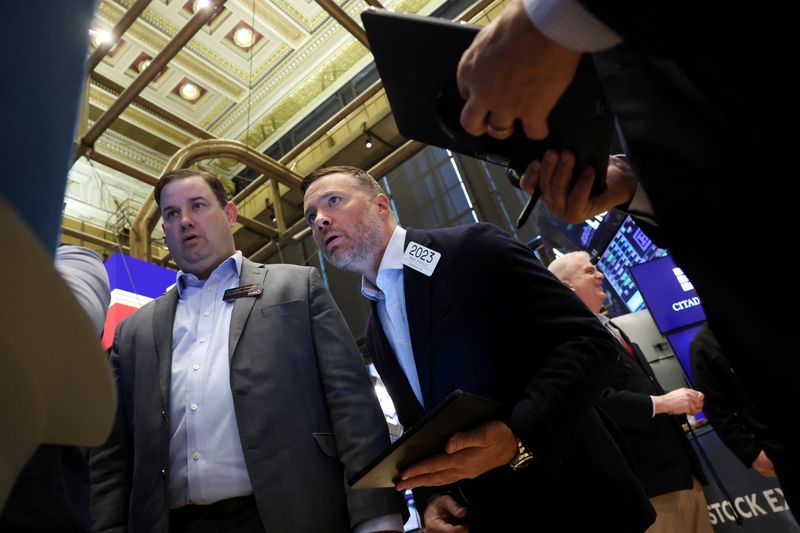U.S. stock futures stay relatively close to the flatline on Wednesday following the implementation of a slew of President Donald Trump’s tariffs on both friends and adversaries alike. The benchmark S&P 500 closes below 5,000 for the first time in almost a year in the previous session, as hopes faded that the Trump administration may be willing to immediately negotiate trade deals with individual countries. Elsewhere, investors will be keeping an eye on earnings from Delta Air Lines (NYSE:DAL) and Constellation Brands (NYSE:STZ), while minutes from the Federal Reserve’s March gathering are due to be released.
1. Futures choppy
U.S. stock futures hovered around the flatline following another round of volatile trading in the prior session, as hopes waned that the Trump administration would soon pursue concessions over its sweeping tariffs.
By 03:34 ET (07:34 GMT), the Dow futures contract had slipped by 74 points, or 0.2%, S&P 500 futures had fallen by 11 points, or 0.2%, and Nasdaq 100 futures had dropped by 18 points, or 0.1%.
The main indices on Wall Street shot higher at the opening bell on Tuesday, partly on expectations that Trump would be open to negotiations on levies with many U.S. trading partners.
But those gains were later erased after White House officials said they would move ahead with slapping an additional 50% tariff on China in response to retaliatory countermeasures from Beijing, bringing U.S. duties on the world’s second biggest economy up to 104%. China, for its part, has promised to fight back against what it has deemed to be blackmail.
U.S. Trade Representative Jamieson Greer also told a Senate committee that Trump had no plans to change his tariff tactics in the near-term despite a multi-day slide in stock markets and deepening fears of a potential recession.
Treasuries extended a sharp sell-off that began on Monday as well. Investors, including hedge funds, have been selling liquid assets to cover margin calls sparked by declines in other asset classes, Reuters reported.
2. Trump tariffs take effect
A slate of Trump’s tariffs, including the 104% levies on China, came into effect on Wednesday, further escalating a global trade conflict and denting market sentiment.
Since Trump revealed plans for across-the-board tariffs at a White House Rose Garden event last week, equities have cratered, with the benchmark S&P 500 sliding close to bear market territory — typically defined as a 20% decline from a recent peak.
On Tuesday, the index ended below 5,000 for the first time in nearly a year. It has now shed $5.83 trillion since Trump’s April 2 tariff announcement — logging the heaviest four days of losses since the S&P 500’s creation in the 1950s.
Trump has broadly dismissed the market turmoil, arguing that it is necessary pain to overhaul perceived unfair trade imbalances. Traders have also flagged uncertainty around the outlook for the tariffs after Trump said the moves could be both “permanent” and a tool to persuade foreign countries to sign favorable trade agreements.
Speaking at the White House on Tuesday, Trump said that “a lot of countries” are keen on making deals, adding that he anticipated China would be among those looking to make an agreement. Trump officials are due to speak with traditionally close U.S. trading partners South Korea and Japan, while Treasury Secretary Scott Bessent is set to meet with Vietnam’s deputy prime minister on Wedesday.
3. Earnings ahead
On the earnings calendar, investors will be keeping tabs on earnings from beverage company Constellation Brands and carrier Delta Air Lines on Wednesday.
Analysts expect Delta — which has already issued a negative preannouncement for the first quarter — to provide fresh insight into the outlook for demand when it reports before the opening bell. Constellation, the owner of beers like Modelo and Pacifico, will release its results after markets in the U.S. close.
“Sentiment around airlines has become extremely negative amid worries that demand will tumble due to the recent tariff-induced macro/financial volatility,” analysts at Vital Knowledge said in a note to clients. “Constellation will shed light not only on the state of consumer demand, but the fallout from tariffs too.”
Recent economic data showed that consumer sentiment plunged in March, prior to the full unveiling of Trump’s tariffs, as Americans fretted over their personal finances, business conditions, and unemployment. Year-ahead inflation expectations also jumped.
The figures suggested that, against the backdrop of levy-driven uncertainty, shoppers were becoming more cautious and may be pulling back on spending on nonessential items. Worries have subsequently arisen around a potential recession in the broader economy, although the latest numbers have not indicated that the U.S. is already in a downturn.
4. FOMC minutes
Minutes from the Federal Reserve’s latest policy meeting are scheduled to be published on Wednesday, although analysts flagged that the impact of the document could be lessened by the series of rapid policy changes from the White House since the central bank’s March gathering.
Still, investors will be looking out for commentary around the Fed’s indication that it will slow the ongoing drawdown of its balance sheet, a process known as quantitative tightening.
The rate-setting Federal Open Market Committee chose to leave interest rates unchanged at its March 19 meeting. Policymakers hinted that they still expect to slash borrowing costs by half a percentage point by the end of 2025, despite pushing up their projections for inflation this year.
Trump’s tariffs have clouded these forecasts. It remains to be seen if the actions will drive up inflationary pressures and weigh on economic activity.
5. Oil slips to four-year low
Oil prices slumped Wednesday, dropping to their lowest levels in more than four years as the trade war between China and the U.S., the world’s two biggest economies, intensified.
At 03:33 ET, Brent futures dropped 2.6% to $61.20 a barrel. U.S. West Texas Intermediate crude futures fell 2.7% to $57.98 a barrel.
These losses follow the escalating tariff war between the U.S. and China, after President Trump increased the duties on Chinese goods to a hefty 104%.
Oil has lost about one-fifth of its value since Trump announced higher tariffs on its trading partners on April 2, the biggest five-day drop since March 2022.




